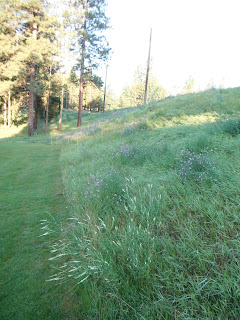For the usual reasons I've been a little behind on updates but this post will be a flurry of quick info and pictures with the hope letting people know what's going on.
We've already aerated and top dressed all the aprons and collars and I hope to do one more session near the end of this summer since this time out we went with smaller tines (there was some comments on how soft they were last year when I aerated them) to lessen the disruption.
One of the absolute worst jobs in almost complete. Edging bunkers is no fun no matter when or how you do it but it's been a while since they've been done so it was definitely time. This time out I am cheating a bit and leaving a lip around the entire perimeter of the bunkers. Normally, we pull the sand up flush with the back lip but this allows the grass to creep into the bunkers which blurs the bunker edge. By creating a lip all around a bunker I hope to limit the maintenance involved in weeding when the grass creeps in.
 |
| Best Bunker Edgers I got |
Unfortunately for these poor fools, they are good at what they do so they have edged most the bunkers. The good news is we really don't have very many bunkers so it is only a short term P.I.T.A. for them. The next step will be going back to select bunkers that are low on sand and top them up.
Some other things we've done include fertilizing tee's. Although the process went well the result were brutal:
 |
| Sh*tty Fertilizer Application |
This is one of the choices I alluded to back in the
March 14 post when referencing on how I was going to make things work based on the tight budget. This turned out to be the wrong choice. For a number of reason including the size of the particle, a general lack of fertility on the tees, the fertilizer source, and the blend of nutrients within the product we applied we got this speckled display. It's more of an issue than just looks. The poor fertility is encouraging certain disease development which will lead to thinning and ultimately bare ground. Solution? The cheapest one I guess. Speaking of disease:
 |
| Fusarium |
There is oodles of these spots on every green and they are getting worse. To be honest this not a real surprise because of the weather we've been having (
56 mm over six days with lows near 2 and highs in the low teens). I was experimenting with an idea I'd read about that basically involved spraying a contact fungicide at very low rates every time you fertilized the greens. The hope was the constant application of this fungicide would never really let the disease get a foot hold and I wouldn't have to apply an expensive systemic and contact to control the disease. I think it was working but obviously weather conditions helped the disease get a real good foot hold. So another idea that needs work.
Another ugly thing you may be seeing on the course relates to a type of winter damage I've yet to talk about.
 |
| Vole Damage |
Voles, look like mice but bigger body and shorter tail, do well under big snow. They really like the grass that is on unfrozen ground and, it seems, on south facing slopes as well. The above picture is from the collar on the front right of 13 green. The little darlings eat right down to and including the crown so there is nothing left to grow back once the spring comes. We are top dressing the eating trails they left behind with a mix of sand and compost and a smattering of seed and we end up with this:
 |
| Top Dressing the Vole Damage |
The picture doesn't really show how mucky the fix is but you'll see what I mean by ugly when you come across these spots. We'll have to revisit these spots for most of June until we have germination.
Other ugly things we are doing include expanding the mowing on certain tee decks. Picture says it all:
 |
| 4T "Expansion" |
And finally, Poa seed head.
 |
| Small, Little Seed Head Spots |
There is bucket loads on the fairway and a fair amount on the greens too. Remember this is next years grass if we have problems so be patient. We did a groom, verti-cut, and lowered the H.O.C. to lessen their presence and mow out the stems associated with seed head production but there is still lots around and they will probably be around until the heat really comes in July.





















































